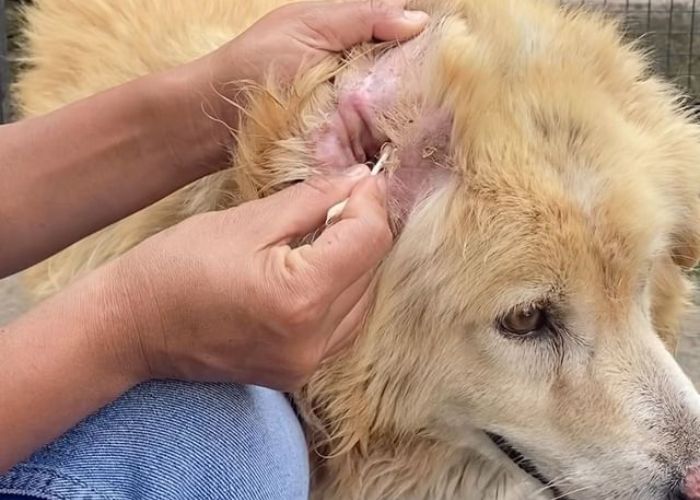When it comes to our furry friends’ well-being, responsible pet owners seek ways to maintain their health and comfort. However, cleaning a dog’s ears with hydrogen peroxide can be risky. Despite its household use for minor wound care, hydrogen peroxide can cause harm when applied to a dog’s delicate ears.
In this article, we explore the reasons why veterinary professionals strongly discourage using hydrogen peroxide for canine ear cleaning and offer safer alternatives to ensure your pet’s oral health remains uncompromised.
Can you use hydrogen peroxide to clean dog ears?

Although some people still use hydrogen peroxide to clean their dog’s ears, it is strongly discouraged by veterinary professionals due to the harm it causes to your pet’s ears.
Firstly, hydrogen peroxide is a potent chemical agent that can cause irritation and discomfort when it comes into contact with the sensitive tissues inside a dog’s ears. This certainly leads to pain, itching, and inflammation, which can distress your pet.
Moreover, prolonged exposure or improper application of hydrogen peroxide can lead to potential damage to the ear tissues hence worsening the problem instead of resolving it.
Additionally, hydrogen peroxide can disrupt the natural balance of healthy bacteria and yeast present in a dog’s ears which play a crucial role in maintaining ear health. Therefore, this imbalance creates an environment conducive to ear infections and other related issues making your dog prone to infections.
Furthermore, there is a risk of hearing loss associated with using hydrogen peroxide in a dog’s ears. If the solution becomes trapped and cannot drain properly, it may create pressure within the ear canal, potentially leading to hearing impairment.
Veterinary professionals recommend using safer alternatives (Veterinary dog cleaning solutions)specifically designed for dogs. These products are gentle on the ears, effectively remove debris, and are free from the potential risks associated with hydrogen peroxide.
To ensure our beloved pets’ well-being, it is best to seek guidance from a veterinarian and use appropriate ear-cleaning products specifically formulated for dogs. By prioritizing their safety, we can maintain their ear health and overall happiness.
How to clean your dog’s ears
Cleaning your dog’s ears is an essential part of their grooming routine, and when done correctly, it can help maintain their ear health and prevent potential issues. Here’s a step-by-step guide on how to clean your dog’s ears:
Step 1: Choose the right time and place
Find a quiet, well-lit area in your home to perform the ear cleaning preferably the bathroom as the process can be messy at times. Make sure your dog is relaxed and comfortable before beginning the process. It’s best to do this after a walk or playtime when your dog is more likely to be calmer.
Step 2: Gather the necessary supplies
Before you start, gather the essential supplies, which may include dog ear cleaner (specifically designed for pets), and cotton balls. For a fun experience, you can include treats to reward your dog for their cooperation.
Step 3: Examine the ears
Gently inspect your dog’s ears for any signs of redness, swelling, or discharge. If you notice anything unusual, consult your veterinarian before proceeding with the cleaning.
Step 4: Apply the ear cleaner
Pour a small amount of the ear cleaner into the ear canal (as directed by the vet ). Gently massage the base of the ear to help distribute the solution and break down any wax or debris.
Step 5: Wipe the ear clean
Take a cotton ball and gently wipe the external ear canal, removing any loosened wax or dirt. Be cautious not to insert the cotton ball inside the ear canal, as it may cause harm or push the wax and debris further inside

Step 6: Reward and repeat
Praise and reward your dog with treats for their cooperation during the process. Repeat the same steps for the other ear.
The Suitable Place to Clean Your Dog’s Ears and Why:
It’s important to choose an appropriate location for cleaning your dog’s ears. The ideal place is indoors, in a calm and familiar environment where your dog feels safe. It also helps monitor your dog’s reaction, address any potential issues promptly, and ensure a more effective and stress-free ear-cleaning experience for both you and your beloved pet.
Avoid doing it outside or in areas with distractions, as this may make your dog uncomfortable or anxious during the process.
Additionally, outdoor environments may contain allergens, debris, or insects that could cause further irritation or complications during the cleaning process.
FAQ
When should I clean my dog’s ears?
The question of when you should clean your dog’s ears depends on a number of things. First, ears are self-cleaning, therefore some dogs don’t need cleaning except after bathing or swimming to dry off the water. Other dogs like those with long ears need regular cleaning as they are prone to infections.
However, cleaning your dog’s ears too often can cause infection since it wipes away the natural protective wax. Therefore, checking your dog’s ears frequently is important to familiarize yourself with its normalcy. This way, you can easily identify any changes, be it dirt or an infection, and act accordingly.
Healthy and clean dog ears are pink, odorless, and not inflamed. If you notice visible dirt and discomfort, like frequent scratching of the ears, it is time to do the cleaning. However, sometimes the signs of your pet’s need to be cleaned may be similar to an infection. If unsure, inquire with a vet before proceeding with the cleaning.
Also, a dog’s ears need to remain dry throughout. Therefore, cleaning their ears after bathing them is essential, mainly to dry off any water in their ears to prevent infection. Also, if your dog swims frequently, you can get topical astringents to prevent water from entering their ear canals; otherwise, be sure to clean them after swimming.
When should I not clean my dog’s ears?
- If your dog has an infection, putting anything in their ears is not a good idea as it can worsen the situation. But, how do you tell that your dog has an ear infection? If your dog enjoys it when you rub his ears but this one time he pulls away when you try to do it, could be he’s having an infection. Also, while frequent scratching mostly indicates that your dog may need cleaning, if a foul smell, redness, discharge, and inflammation accompany it, it could be a clear sign of infection. On such occasions, it is best to seek veterinary care to address the infection properly.
- If your dog has recently undergone ear-related surgery or has suffered an injury to their ears, avoid attempting any ear cleaning until the area has healed completely. Cleaning during this time could interfere with the healing process and lead to complications.
- If your dog becomes nervous, anxious, or aggressive during ear cleaning attempts, it is essential to prioritize their safety and well-being. Forcing the procedure in such cases can be counterproductive and stressful for your pet.
- If you suspect that there may be a foreign object lodged in your dog’s ear, do not attempt to remove it yourself. Trying to remove objects without proper knowledge and tools may lead to further complications. Seek immediate veterinary assistance.
In conclusion, always use products specifically formulated for dogs, as other substances may cause reactions or harm to their ears.